Here are some quick to prepare and calorically dense instant foods to stockpile.
Regardless of if you have a mountain of MREs and canned beans or your prepper pantry is nearly empty, a stockpile of versatile instant foods will always give you a leg up.
Yet these instant foods are the sort of thing that the average Joe will also rush to stockpile anytime a potential disaster looms on the horizon.
The good news is that a lot of the best instant foods have long shelf-lives, and you can still use them in the kitchen as they age to keep a constant rotation. This includes many of the following.
Dehydrated Soups

Shelf Life: Up to 5 years
Calories Per Serving: 135 to 150
Dehydrated freeze-dried soups are one of the best instant foods you can stockpile to be prepared for an emergency. The trick to using dehydrated soup as an instant food is to choose one without solid chunks.
The manly chili might sound tasty, but it will take half an hour of cooking to get the dehydrated beans soft. Instead, target potato soup and broccoli cheese soup. You can rehydrate them quickly, and even use them as a base to add other fresh or canned ingredients.
Related: 5 Instant Dry Soup Mixes Every Prepper Should Have
Years ago, I used instant potato soup as my lunch on a very cold, and very unsuccessful late fall elk hunting trip. Every morning I’d pour some soup mix with some hot water, a pat of butter and whatever random hunks of meat into a thermos. I’d stuff it deep in my pack to let it mix together from the agitation of my walking.
All the other guys in my group would spend their lunch chipping their teeth on frozen protein and snickers bars or wearing out their jaw muscles on cold beef jerky. Meanwhile I’d be sipping down warm potato soup that tasted like something Grandma made special for me!
Canned Chicken
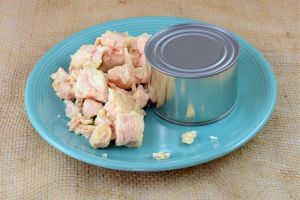 Shelf Life: 3 to 4 Years
Shelf Life: 3 to 4 Years
Calories Per Serving: 90 to 130
Canned chicken is another popular ready to eat food that you’ll need to stockpile before it vanishes from store shelves. While it too can be packed in oil, you most commonly see it packed in water.
If you have a choice, the one that’s best for you will depend on how you use it. If you want to simply open the can and eat it in the field on the go, chicken in water is the more palatable option. If you’re going to use it to cook, chicken in oil is more pan friendly. It also tends to smell less like cat food.
If you raise chickens or have a little extra cash to buy fresh meat, I highly recommend this canning method that I’ve been using to preserve chicken and beef. It lasts over a decade, tastes way better than store-bought canned chicken, and you get to control exactly what goes into it—unlike the store-bought versions that often contain preservatives and unhealthy additives.
Peanut Butter
 Shelf Life: 6 to 24 Months
Shelf Life: 6 to 24 Months
Calories Per Serving: 190 to 210 for 2 Tbs
Peanut butter is arguably the number one food to stockpile as it will disappear the fastest from store shelves when panic-buying starts.
It’s calorically dense, so you can keep a lot of food value in a relatively small space. Perfect for a bug-out bag or just to keep you fed on a multi-day hunting trip.
Peanut butter is also a good source of protein and healthy fats. However, it can be a little high in sodium. All-natural peanut butter has the best nutrient value and least unhealthy additives.
The tradeoff is that it only has a shelf life of around 6 months unopened. A jar of commercially processed peanut butter with additives and preservatives can have a shelf life of up to 2 years unopened.
Powdered Fruit Juice and Sports Drinks
 Shelf Life: 6 to 12 months
Shelf Life: 6 to 12 months
Calories Per Serving: 60 to 180
When it comes to instant foods for a stockpile powdered fruit juice and sports drinks might not sound all that filling. They might even sound like luxury items or things you’d include to appease the kids.
However, the over-arching value to powdered fruit juice and sports drinks is in their hydration capacity and the vitamins they bring. This includes quick digesting sugars like dextrose, which can help in times when you’re dealing with low blood sugar. This can come in handy in times when you need energy to do something like haul a field-dressed deer back to camp.
A lot of powdered fruit juices can also provide you with a quick dose of carotenoids, lutein, lycopene, folate, vitamin C, and vitamin E. All are key nutrients that might be hard to come by during a prolonged crisis.
For sustained energy and overall health, consider adding this Dual-Extracted Reishi Mushroom Tincture to your supplies. Unlike energy drinks that offer only a temporary boost, Reishi combats fatigue and helps maintain balanced blood sugar, preventing those energy crashes when you need to stay alert.
This powerful adaptogen not only aids the body in coping with stress but also promotes restorative sleep and boosts immune function—crucial in unpredictable situations.
In a survival scenario, where every ounce of energy counts, this tincture can help sustain your stamina and overall well-being, making it a smarter choice than conventional energy drinks.
Instant Powdered Milk
 Shelf Life: 3 to 10 years
Shelf Life: 3 to 10 years
Calories Per Serving: 55 to 80
Powdered milk is another staple instant food that needs to be featured in your stockpile. It’s the sort of thing everyone will think about and rush to in hopes of keeping some form of dairy in their diet.
It’s also the sort of additive that you can put in other low-calorie foods, and soups to give them more nutritional value.
The shelf life of instant powdered milk can vary. The fat content and the storage temperature will greatly shorten or increase the shelf life of powdered milk. Non-fat powdered milk that’s kept frozen might be good for two decades or more. Whereas whole powdered might only be good for 18 to 24 months.
The wise move here might be to put some nonfat powdered milk in cold storage and leave it there for safe keeping. Then every 18 months or so buy some whole powdered milk and rotate the old stock for use.
Rolled Oats
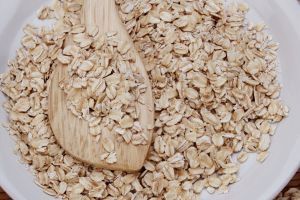 Shelf Life: Up to 24 months
Shelf Life: Up to 24 months
Calories Per Serving: 150 to 160
While they’re primarily meant to be used as a quick oatmeal breakfast cereal, rolled oats can be extremely versatile. This makes them appealing to rotate through your stocks for use every two years or so.
They can be used to make a wide range of baked goods, like pies, cookies, crumbles and crisps. You can even mix them into improvised granola and protein bars to add some bulk, along with much-needed dietary fiber.
You can also grind rolled oats into oat flour, which can be used as a thickener for stews and other dishes. Oat flour can even be used to make tortillas, which gives you another way to break the monotony of an instant food diet. I still have fond memories of rabbit and foraged ramp burritos in improvised oat tortillas, from a wilderness survival retreat in my 20s.
Instant Potatoes
 Shelf Life: Up to 3 years
Shelf Life: Up to 3 years
Calories Per Serving: 110 to 145
Instant mashed potatoes are one of the top priority instant foods to stockpile for a potential emergency. They can be rehydrated to a different consistency to add to their versatility.
Adding more moisture gives you a potato soup base. Less moisture, a little bit of flour and an egg and you can make potato dumplings like gnocchi. This can really help break up the monotony of bulk instant foods!
Instant mashed potatoes, while convenient, aren’t as nutritious as fresh potatoes. They lose some of their natural vitamins and minerals during processing, especially compared to the nutrient density of whole potatoes.
If you’re looking to preserve that nutrition while still getting long-term storage, learn here how to can potatoes for a 5+ year shelf life. This way, you can enjoy the benefits of real potatoes even during an extended crisis.
Tuna in Cans or Pouches
 Shelf Life: 3 to 4 years
Shelf Life: 3 to 4 years
Calories Per Serving: 70 to 120 or 230 to 280 (Varies by Type)
Of all the canned foods that will disappear first, tuna is the one most panic shoppers will reach for first. It’s what they know, and it’s high in protein as well as versatile.
However, there are a lot of different types to consider. The calories per serving and the quality of the tuna can vary wildly depending on the type of package and the medium inside.
Instant Grits & Instant Brown Rice
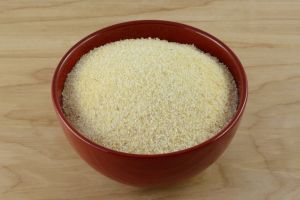 Shelf Life: Up 2 to 3 Years before opened
Shelf Life: Up 2 to 3 Years before opened
Calories Per Serving 120 to 230
Instant grits and instant brown rice are an important thing to keep in your stockpile to add belly-filling bulk and fiber to other foods.
They aren’t particularly packed with nutrients beyond some basic carbs, a little protein and some soluble fiber.
It’s their belly filling value that puts them in such high demand. You can mix them with a wide range of meats to make them more filling and stretch your protein source. You can use them to bulk up soups or as a base to stir in thin sauces.
When times were tough in the later days of the Great Depression and World War Two, my grandmother turned to rice to work her magic. She worked at a local restaurant and would bring home bones leftover after butchering primal cuts. Then she’d make a stew from the marrow and meat scraps, and cooked the rice in it until it soaked it up. It was one of the staple ways she kept 6 children fed.
As you consider the best instant foods to stockpile, remember that a comprehensive food reserve is crucial for long-term survival. This well-rounded guide offers insights on building a lasting stockpile that doesn’t rely on refrigeration, helping you prepare for any crisis.
It highlights affordable, nutrient-dense options and offers a meal-by-meal rationing system to help you maintain your strength and health during tough times.
With expert advice on everything from must-have canned goods to overlooked survival foods and practical storage tips, this guide is an essential resource for any prepper looking to enhance their emergency food supplies.
You may also like:
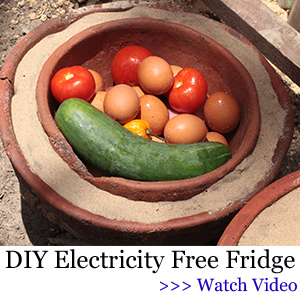 Better Than Having a Water Stockpile
Better Than Having a Water Stockpile
Fast-Growing Vegetables You Should Grow in a Crisis (Video)
How Far Away Would You Need to Be to Survive a Nuclear Blast?
Survival Shelters Every Prepper Should Know
What Livestock My Grandparents Raised During the Great Depression

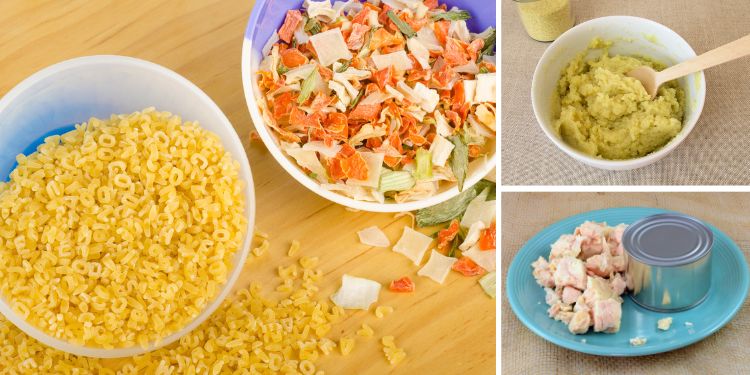













Most of the foods mentioned in this article require only
water and fire.That is a very good thing.
There are several bread products that should be considered.
Jiffy Biscuit Mix and Krusteaz Pancake Mix.
The Coleman Stove Top Oven is still in production and
can be found online and many sporting goods stores.
They do require constant monitoring for temperature
control.If the power is out and you cook or bake using
natural gas a good quality Rocket Stove will do the job
and will burn any wood product.I like pine cones.
I can’t say it enough.Fire and water.
If you are on the move, or just short on time these instant foods have their place. And you are right Chuck, Keep It Simple Stupid, just fire and water. A rocket stove is a good approach (I have a nice one I built) but I have become a fan of the Kelly Ketel. The water chamber surrounding the fire area really makes for some fast hot water with very little fuel. Pine cones and small twigs are all you need. If I am car camping or just playing around in the back yard I am going to do my baking in the dutch oven, its just what works for me.
Which of the many commercial made rocket stoves is the best, heavy stationary type or lightweight foldable type and what metal is the best for long term use?
I have seen a couple rocket stoves that heavy that are fire brick lined, most not for backpacking use. Do most people plan to carry their rocket stove on trips or keep it in one place such as home base?
Hey, Chuck: Great thoughts! The issue is that our entire household is not able to eat gluten, worst of all wheat. We use Pamela’s Pancake and Baking mix, which is down right AWESOME, but of course much more pricey than Jiffy Biscuit Mix and probably healthier for you, too. We also bought just recently a Camp Chef camp oven with the two burners on top. Uses Propane, and we love it. It is big enough to even take 2 loaf pans for making bread, if you want to do that. All good ideas, though I do think our distiller will get a work out once the stored water is gone. Thanks for all of your amazing wisdom you share so kindly and so often!
ovens are great for bread but my wife and i also really like fried breads, easy to make and quick to cook.
flour or a really nutritious corn bread that will store for a week, ready in minutes fried.
remember corn dodgers?
Be careful of storing the “biscuit mix” and instant potato type products. I have found that the oils in those types of products makes them go bad pretty quick. Leaving you with rancid food. Also the article mentioned brown rice and grits. Brown rice will not store nearly as long as white rice varieties. Grits are also not a very good long term storage item. Corn is notorious for having mold, so unless you freeze it, it’s not a great shelf stable item.
I agee with Chuck mostly on the Coleman stove top oven… I’ve been using one for about 50yrs in my camping escapades … I reside rurally and am on propane.. and surrounded by woods/forests, so you know I loose power often… but my kitchen stove works just fine in those events, with my Coleman dual fuel stove and oven as a back up… As for a Rocket Stove, I just need to gather up the material and make one in my shop… I’ve seen them in use and was impressed… and your right, Fire and Water… Have a nice day…
Most Dried Foods
Milk
Eggs
cereals
beans
oats
Honey
salt
sugar
spices
bullions
so many options , so many choices
because God is Great and Loving he has provided for all
there is plenty for all who seek , look, ask , follow the way , the truth , the life
Grace for all , good blessings
We are in a time of Revelations , at the end of the millinium of time , the time before the end
when all will be revealed and deception will abound , when all will be displayed for the intent of the heart of mankind
Those who choose well will reap the benefit of Holy, just, purity from a loving , forgiving God who want all to come to salvation thru Jesus Christ
There will come a time when you will not be able to find , or have truth , for the love of many will grow cold and the lust of many will take hold .
so plan well , pray well , prepare well , and be on guard for the devil will sift your soul to see who you choose .
It is the Time of the Harvest
What is added in our common foods these days?
Beware there are processed commercial foods that are made with GMO’s and bioengineered ingredients, most commercial food at grocery stores are processed.
There are two types; good and bad processed foods, most packaged food have preservatives added to keep food fresh on in the warehouse to the grocery stores sitting there.
The good processed food, yes when we cook, follow a recipe we are processing food but not adding in preservative ingredients that cause health issues.
That is the difference.
But are those survival foods made or not made with GMO’s or bioengineered ingredients to keep those foods safe for up to the magic 25 year period some companies claim?
Do your own research in what we have for our prepper safe foods for emergencies.
It was considered GMO’s were the bad things but now we also have bioengineered ingredients added to our name brand products we buy at the grocery stores today.
Just what are the real skinny on what is considered an bioengineered ingredient, is that another name for GMO?
Bioengineered reminds me of the fake lab grown meat that vegans and environmentalism groups want us to eat in place of real meat. What the heck do these vegans think they should all dictate what us normal Americans should be eating?
I am not going to eat insects because the United Nations says we should to be good little communists. The whole UN is run by Jew hating antisemitic Islamic countries. Isn’t it time to move the UN out of the USA?
Any way interesting article about rehashed information most of us know already.
I am concerned about the quality of survival food and the expensive cost trying to get a “25” year survival food stash on a fixed income, it ain’t cheap to prep anymore.
I am a Vegan & we do not want you to eat lab meat. It would be nice as your conscience is raised if you would choose compassion in your diet BUT we do expect you to eat artificial meat. We like it for ourselves! Running into Burger King for an Impossible whopper is a real treat. I am offended by your ignorant statatement. Stay in your own lane…
if veganism is so great, why do they keep trying to make it taste like meat?
I understand the GMO/Bioengineering concerns, but it all isn’t bad, always remember that long ago a group of people started with teosinte and through selective breeding ended up with the corn that we know today.
Bioengineered is just the start, IMO. Everything that is NOT prepared from scratch in your home is ultra-processed. Some are saying it is the cause behind many of the illnesses people suffer from today. I’m trying to avoid it. But back to today’s subject. For the time we will need to be prepared I’m thinking we can withstand the chemical additives and bioengineering for a short period of time. To have food and water available will be paramount.
On the other hand, most things REQUIRE WATER! If SHTF, no running water will be available. How many have water barrels? We have 6 and a jacuzzi .. so what happens when they are empty?
You also have about 40-50 gallons of great water in your hot water tank too.
Not counting what is in the pipes.
Unfortunately, Geri, water will be the number one problem if our enemies destroy the electrical grid completely. Some estimates are that it MAY take a decade or more to get things up and running again with even the slightest semblance of normality. I know that I’m preaching to the choir but it bears repeating to drive the point home. We can do without food for approx. a month or so. At that point we’ll be VERY hungry. It will not be pleasant by any means but it is doable. We’ll still be alive. 3 or 4 days without water and we start running into serious problems. If the grid is completely destroyed and it takes years to even get a minimal grid up and running an extra 40 or 50 gallons of water ain’t gonna do it. Having rain barrels is great but it has to rain to fill them up. Not something we can depend on. If that happens in my area I’ll have no choice but to dig a well while I’m still fairly strong and might still have SOME potable water on hand. Water is a bugger to store. It takes up SO much room. Where I am the water table shouldn’t be much more than about 50 feet down so even if I have to dig it by hand it should be possible but not easy. I know how to do it. My grandfather showed me. In a total grid down situation water becomes our #1 priority. And then that water needs to be filtered and boiled. I don’t know if I would want to drink modern well water directly from the well. So much crap in the ground now. Water test kits may be another item to stock up on. And it may also be a good idea to learn how to dowse for water so that if you’re forced to dig for it you don’t waste your time and energy digging in the wrong place.
the lack of clean potable water will kill many in a long term grid down event from lack of, or diseases from drinking from unsafe water sources through desperation.
water filters will only last so long for those who have them and then what.
please plan ahead for that. water is the most important thing to me. i’m like an old goat, i can eat almost anything, but i will need water everyday.
clean drinking water will also be a major bartering item after the fall in infrastructure. think about that. i have a good deep well.
This is where storing the water that comes off your roof would be invaluable. We have a couple of water tanks, despite being in the suburbs. In units or flats, you’d have to try to collect off your balcony or windows I suppose. Where there is a will there is a way. Even basins or buckets left out to collect water would be something at least.
Buy a canner and start canning greenbeans, corn, soups, chicken, stews. Initial investment, depends on the size canner you purchase
Note: make sure you buy a canning pressure cooker!, I’d plan to spend around three to four hundred on the canner and buy several boxes of glass jars both quart and pint sizes, say another two hundred and extra boxes of both pint and quart lids. Your canner should come with instructions, you can watch and learn on you tube. When ready to begin try canning water. I keep canned water in half gallon jars in my basement in a dark corner out of sunlight. Then try canning green beans, then move on to more complicated foods. Be sure to put salt in any foods you plan to can for preservation purposes.
Happy canning g everyone
Renee
we have been canning our gardens for almost 40 yrs now. for a long time we used a presto canner and it worked well. 20 yrs ago it went belly up and i popped for an All American caner and we have never looked back, it’s not cheap but it will become a family heirloom. best money i ever spent.
also look into the Superior canning lids, that’s all we have used for a long time since Ball and Kerr moved to China.
and yes, salt is important as well as vinegar and citric acid depending on what you are canning. Guide to Home Canning is a good guide to those just getting started.
best of luck to all
good practice idea !
But we rely on dehydrated water for our survival water source.
I am brand new to canning, just did pickles this year, the cold method canning – warm my jars and spice in hot water bath, remove jars, pack cukes, add water salt vinegar at boiling point. cap and cool. I am told this method will only save them for about 18 months, but who cares, my pickles will never last that long, crunch ! it makes for a FIRM crunchy Pickle, my spice mix is heavy Garlic, heavy red pepper, heavy black pepper, medium dill. a friend calls them Crack-pickles. An open jar is an empty jar
I forgot the important part ! ! !
Also I recommend pickle making with extra fresh cauliflower ( its Ok, will keep it, and better enjoyment than frozen).
BUT MOST OF ALL, I recommend pickling & canning your extra green beans when they are growing faster than you can eat and freeze/ can. Remember, they are called pickles, not cucumbers with spice. pickled green beans are top shelf !
I have a great pressure canner for under $100, and is a double decker. Love it.
Renee: Lady, you could be my twin sister! I can a LOT of foods, and just love pressure canning, too. It is so easy once you stop worrying and just set a timer and occasionally double check the pressure is fine during the 1hr-1hr. 10 mins. most things take for our foods. Yes, you have to wait for it to cool down later to get the jars out, but HEY, it is sure nice to not have to worry about breaking jars and losing your food, like has happened with my waterbacth canner several times. It is so easy, cause you don’t have to do all the messing around with lids or rings. Just clean the rim of the jar IF IT NEEDS IT, and put the lid and ring on and set it in the canner (and once the pressure comes up, then walk away or read a book and while it is processing). Of course, you must reference any instruction book to know how long to process that type of food, but once you’ve got it, it’s a breeze!! I find pressure-canning meat so EASY PEEZEY!! What a blessing!!
Forgot to say that I am blessed. My mother had the double stacker Presto pressure canner and left it to me when she died. I use it frequently, all year round! We also have a Harvest Right Freeze Drier, which is awesome! About water, we have a contaminated “pond” of sorts behind our home, so we can get water and then distill or filter it, THANK GOD! STILL, we do have 14 Water Bricks for storage and 11 5 gallon jugs of water, as well as a 50 gallon barrel or 2.
About rehydrating beans and cooking dehydrated items –
Fill a REAL type thermos with hot water. Double wall, vacuum is best)
Add in your ingredients.
While waiting for the stuff to finish, gather firewood, sanitize water, pester the wife and kids with board games and other, or something productive.
It will self cook/rehydrate on it’s own.
Most food can keep indefinitely if you can store them frozen below 0 deg F. Colder the better.
Foods packed in water can help because that water is sanitized.
Rain barrels are ok *IF* your rain is not contaminated – fallout, chemical dispersion from weapons, bird droppings, asphalt singles (newer they are the more chemicals they leech out),
Assume that all water outside is contaminated in some way or another.
While I agree with most of what the author said my personal preferences would be our wonderful spam instead of canned chicken. Yes, I know what spam is and how much everyone loves it. Oh, BTW, speaking of peanut butter; it will last almost forever. It’s not the peanut butter itself that becomes rancid but the peanut oil that becomes rancid and it accumulates near the top. If the peanut butter is well past it’s “due by” date just scoop the first half inch or so out of the jar and feed it to the squirrels to fatten them up when you hunt them for that little bit of extra meat. When you’re scooping the rancid oil out of the jar you can tell by the consistency what is good and what is bad. The “bad” peanut butter only goes down about half an inch. I know friends that have done this and I’ve tried their peanut butter and it was fine. This method works great. This method may waste the first half inch or so but then the rest is edible. I prefer canned salmon instead of canned tuna. Personal choice. You can tune a piano but you can’t tuna fish. Ha. Ha. Old joke. I stay away from brown rice. White stores MUCH better. Again almost forever if kept cool and dry and secure from vermin.
old peanut butter and large rat traps will put meat on the table in a pinch.
we are all looking for emergency food, thats almost free, delicious, easy to store, easy to prepare, and well, more easy free delicious is better. BUT yell loud if you find it. a few thoughts and observations, when I was about 9 years old, we ate CANNED peanut butter, left from Korea or WWII, I am not sure. it was edible as it was, but Dad bought and mixed in some peanut Oil and it was just like fresh from the store. So, If I can find some in the can, I would consider the shelf life to be at least 30 years ( others say 2 years, in store plastic container). Rice, 2 years maybe 3 they say. I have been buying in BULK 50 lb bag, double bag it, Vac Pack it (otherwise it stabs thru 1 layer and destroys the vac). and I am eating the last of it when I get to it. after 5 years I am opening the last of it and filling my cupboard jug, that lasts a good 6 months, cant tell it from store fresh the same day !
Store it right ! vac pack what shouldn’t even need to be, and things will last a LOT longer. If you get the itchy feeling, run to the Bulk store and buy 100 lbs of rice. A hungry man will trade an ounce of gold for 6 Oz of uncooked rice – just ask every day until he says YES. be prepared to say NO to every demand for your food, unless your ready to trade.
Their is a lot hidden between these words, a good prepper can find them and understand them. Remember, were ready, were not eager.
After following through with this article, I still have to agree with Chuck… I moved to a rural location, small old, very old farm house on a few acres, surrounded by woods/forests, just to get away from a huge Metromess… I have my own water, with or without electricity, and after my propane runs out, I can gather wood to cook and or heat my abode… I do have a garden, and enjoy its fruits of the harvest, as well as a few fruit trees, I also have the ability to harvest fresh meat, wither it be domestic or wild… so becoming a vegan is out,.. I might say that I do feel somewhat sorry for vegans who don’t get to enjoy the medium rare cooked ribeye steak, and or some maple smoke sausage with my fresh eggs for breakfast…LOL.. May we all live long and prosper…
When it comes to starving or not i don’t think i will be to concern whether or not it’s got GMO’s or is organic…small solo wood stoves….. supply of small dry twigs….some lighters. cooking pots…knowledge of edible wild plants…ect…good to go….i like this article’s recommendation’s oh ya…water…shelter….sounds like camping….fishing poles ….rat traps…high power air gun…i day dream of this every day…sound’s better than trying to pay my bills ….I better watch out for what i dream about….Get out and vote…you know the drill…Peace